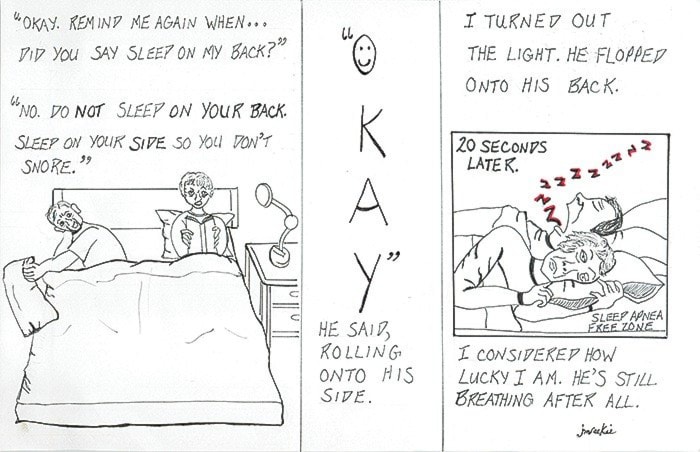THIRD IN A SERIES
Long time area resident Jocelyn Reekie and her husband Bill are a family dealing with Alzheimer’s Disease and wanted to bring the struggle out of the shadows and into public consciousness. So they have decided to write about their situation in an effort to inform and support anyone else who may be in similar circumstances.
Note:The B.C. Alzheimer Society wants those wishing to attend the caregivers’ support group mentioned in last week’s article to contact Jane Hope at 1-800-462-2833 prior to attending the group.
Jocelyn Reekie
Special to the Mirror
“Living with someone with dementia is like living with a child.”
It’s a common perception. But is it true?
Children are mimics.
They follow adults’ examples (especially the ones you’d rather they didn’t see) and challenge parents to find ways to communicate with them that will encourage them to develop good life skills and protect them from harm.
We try to teach them to be aware of their surroundings, to honour the sensibilities of others, to follow the order of law that governs our society, to question and explore.
In other words, we strive to raise self-confident, skilled, empathic, honourable, engaged citizens.
It’s a tall order.
It takes every skill parents possess, plus the skills of the dozens of other ‘teachers’ who influence children along the way.
Unless a child is developmentally challenged, they develop on a continuum.
They start out requiring total care and supervision.
As they grow, they learn to do things for themselves, to think for themselves, their circle widens, and they may surpass their teachers in skills acquired.
Some believe that as Alzheimer’s disease progresses, the patient reverts to a child-like state and then a baby-like state.
Physically, they do require more and more care. But Alzheimer’s patients are not children or babies.
They have spent a lifetime acquiring skills and opinions, and have grown into their own ways of doing things.
They have been valued members of society.
They cannot be solaced by being picked up and carried, or made to laugh by blowing a raspberry on their bellies. (Okay, that one might be up for discussion).
And while children are busy gaining knowledge, learning how to plan, and to imagine possibilities and work toward a result by taking those possibilities into account, Alzheimer’s patients are losing their vast store of knowledge, and the ability to imagine.
Like a fire that starts in one corner of a room and burns through a house wiping out a lifetime’s belongings, the storage rooms in Alzheimer’s patients’ brains are destroyed. Some belongings lost in a fire can be replaced, some things cannot.
Alzheimer’s is like the things that can’t. When the parts of the brain that govern various skills and bodily functions are destroyed, in an Alzheimer’s patient, those things are gone forever.
What that means in part is that no matter how many times one tries to explain something to an Alzheimer’s patient, the patient will not be able to recall or relearn how to perform a task they have forgotten how to do, or remember what’s been said to them.
Nor will they be able to learn new tasks.
However, they will often know there is something they should be able to do, but can’t, which leads to incredible frustration.
And they will remember how what’s said to them made them feel, which can lead to sadness on their part and regret on the caregiver’s part.
Those things are often hard for a caregiver to understand, and to accept.
It’s not stubbornness, a lack of will, or stupidity on the patient’s part that is causing problems. It’s a dying brain.
This is a disease in which the goal posts move.
Things can change from month to month, or even hour to hour.
Frustration is part of the package.
There will be times caregivers as well as patients need to allow ourselves to vent and to cry.
But we need to find ways to do this that don’t cause more pain.
In the midst of a difficult situation, taking deep breaths when the volume is rising, stepping away to collect one’s thoughts, can help.
Later, it’s important to take time to assess how things have changed, and how one can deal with the changes.
Keeping a diary can help.
Hearing or reading other people’s stories can also provide valuable insights.
And remember to laugh.
The other night Bill got up to go to the bathroom.
For some reason, he put his pillow on the floor.
When he returned and got into bed, he looked bewildered.
“Lose something?” I asked.
“Yeah. I think so.”
He continued to look around.
“Lie down,” I said.
He did.
“What are you missing?”
His head swivelled.
He spied my pillow. “A pillow.”
He sat up and started to hunt in his covers for it.
Eventually he spotted it on the floor.
“You know you’re fodder for a book someday,” I said, grinning.
He laughed. “Yeah.”
His laugh is deep and rolls out of him.
It’s infectious.
“Would you be upset if I did write about us?” I asked.
“Nope.”
“Good. Because I already have.”
We both laughed. “Consider yourself warned…again.” (I clear it with him every time I write something).
“And sleep on your side, not your back.”
